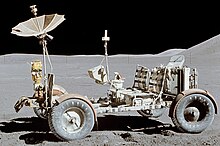Buggy (automobile)
Appearance
| Buggy | |
|---|---|
 Volkswagen Country Buggy, a military buggy | |
| Overview | |
| Manufacturer | Many |
| Body and chassis | |
| Body style | Lightweight |
| Related | Horse and buggy |
Buggy is generally used to refer to any lightweight automobile with off-road capabilities and sparse bodywork. Most are built either as a kit car or from scratch.
History
[edit]The word buggy was originally used in England to describe a lightweight two-wheeled carriage for one person,[1]: 121 and later in America to describe a common 4-wheeled carriage.[2]: 25 The term was extended to lightweight automobiles as they became popular.[3][4] As automobiles became increasingly sophisticated, the term briefly dropped out of use before being revived to describe more specialised off-road vehicles.[5][6][7]
Types
[edit]
- Bennett buggy, a Canadian, depression era term for an automobile pulled by a horse
- Dune buggy, designed for use on sand dunes
- Baja Bug, a modified Volkswagen Beetle
- Moon buggy, nickname for the Lunar Roving Vehicle used on the Moon during the Apollo program's Apollo 15, Apollo 16, and Apollo 17 missions
- Sandrail, a variant of the dune buggy
- Swamp buggy, designed for use in swamps
- Rock buggy, designed for use in low-speed rock-crawling applications
- Rock bouncer, designed for use in high-speed rock-crawling/bashing or very steep, off-road hillclimb racing, typically tubular steel exoskeleton, 1000hp V8 petrol engine
See also
[edit]References
[edit]- ^ Felton, William (1996) [1796]. A Treatise on Carriages (Reprint of both volumes). Astragal Press. ISBN 1879335700. OL 21753408M. (Original Vol I, Original Vol II)
- ^ Smith, D.J.M. (1988). A Dictionary of Horse Drawn Vehicles. J. A. Allen & Co. Ltd. ISBN 0851314686. OL 11597864M.
- ^ "Advantages of the automobile buggy". Popular Mechanics. Hearst Magazines. July 1909. p. 72. Retrieved 14 August 2013.
- ^ "untitled". Logansport (Indiana) Daily Reporter. 4 December 1901. p. 3.
He is catapulted through space by the explosion of a 'gasoline buggy'.
- ^ "Amphibian 'Marsh buggy' used to hunt oil". Popular Mechanics. Hearst Magazines. April 1937. p. 529. Retrieved 14 August 2013.
- ^ "Jungle Buggy packs a load". Popular Science. May 1948. p. 122. Retrieved 14 August 2013.
- ^ Hunn, Max (October 1954). "Swamp-buggy Steeplechase". Popular Mechanics. p. 137. Retrieved 14 August 2013.
